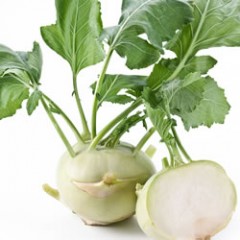Kohlrabi
 Kohlrabi is a minor crop in New York, but is popular at farmers markets and other retail stands. Its mild flavor makes it favorable to eating fresh and even young children like it when cut up and served like carrot or celery sticks. Both green and purple varieties are available. It is best grown in cooler temperatures and is typically available in June and July and then again in September and October. Kohlrabi is a member of the Brassicaceae or cabbage family which also includes broccoli, cauliflower and turnips. It can be susceptible to many of the same diseases and insects as other members of this family.
Kohlrabi is a minor crop in New York, but is popular at farmers markets and other retail stands. Its mild flavor makes it favorable to eating fresh and even young children like it when cut up and served like carrot or celery sticks. Both green and purple varieties are available. It is best grown in cooler temperatures and is typically available in June and July and then again in September and October. Kohlrabi is a member of the Brassicaceae or cabbage family which also includes broccoli, cauliflower and turnips. It can be susceptible to many of the same diseases and insects as other members of this family.Relevant Events
2025 Potato Advisory Meeting
December 16, 2025
Canandaigua, NY
2026 Finger Lakes Produce Auction Winter Growers Meeting
January 8, 2026
Penn Yan, NY
New Crop Rotation Recommendations for Swede Midge
Christy Hoepting, Extension Vegetable Specialist
Cornell Vegetable Program

New Cornell research has demonstrated that brassica crop rotations of 500 ft (down from 3000 ft) and 3 months (down from 3 years) could effectively "crash" a swede midge population when fields are secluded from each other, making crop rotation a much more feasible strategy for small farms. A new fact sheet details the new crop rotation recommendations and provides information on the pest's life cycle, biology, and crop preferences in addition to real-world examples of crop rotation. The crop rotation strategies were developed to serve the needs of small organic farmers, but have utility for conventional farmers as well.
Video: New York State Produce Auctions

Currently, there are 8 produce auctions in New York State. These auctions are aggregation points that allow local farmers to sell their produce in wholesale lots to buyers from across the region. To document the economic impact of produce auctions on agriculture, local businesses, family farms, and produce buyers, the Cornell Vegetable Program worked with Harvest New York to survey top sellers and buyers.
A new Cornell Vegetable Program video shares general information about produce auctions, how buyers and sellers use the auctions to expand their businesses, and how local communities benefit from them.
Video: Swede Midge

Swede midge is an invasive insect pest that is threatening the viability of broccoli, cauliflower, cabbage, Brussels sprouts, kale, kohlrabi and turnip production within the Cornell Vegetable Program region and throughout the Northeastern US. This short video will provide you with some general information about this pest and how to scout for it in your Brassicas.
Extending the Harvest Season with Fall Production
Robert Hadad, Extension Vegetable Specialist
Cornell Vegetable Program

Late season production starts in mid spring. For a successful crop, start with a detailed plan. Designate an area specific for late season production so that management can take place in one spot rather than all over the farm. This will make cultivation, pest management, using row cover, and harvesting more efficient to manage.

Upcoming Events
2025 Potato Advisory Meeting
December 16, 2025
Canandaigua, NY
Come hear the latest on insect pest control and fertility management in potatoes from Cornell University experts. Potato variety trial updates will be shared too. After lunch will be the Empire State Potato Grower's Meeting. 1.5 DEC credits in 10, 1a, and 23.
2026 Finger Lakes Produce Auction Winter Growers Meeting
January 8, 2026
Penn Yan, NY
At this vegetable grower-focused meeting, ag industry experts will discuss food safety, disease management in strawberries, the benefits of using cover crops, plus more. Two grower panel discussions will focus on pest management techniques and irrigation. DEC recertification credits offered in categories 10, 1a, 21, 22, 23, and 24.


































